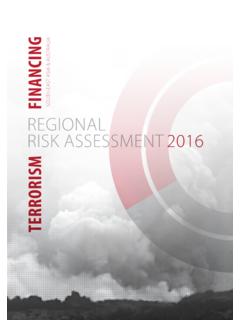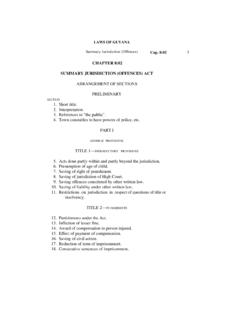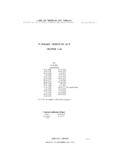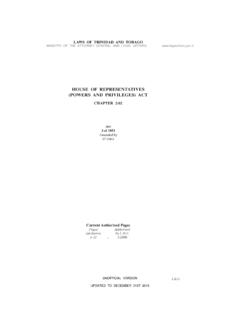Transcription of AUSTRALIA’S FINANCIAL PLANNING SECTOR >>>
1 australia 'S. FINANCIAL PLANNING . SECTOR >>>. MONEY LAUNDERING AND TERRORISM FINANCING. RISK ASSESSMENT. 02 RISK ASSESSMENT: FINANCIAL PLANNING SECTOR . australia 'S. FINANCIAL PLANNING SECTOR . $ 1,574. FINANCIAL . BILLION PLANNING . IN REVENUE* BUSINESSES*. 20%. OF ADULT AUSTRALIANS. 25,000+. FINANCIAL . SEEK FINANCIAL PLANNERS **. A D V I C E**. SUSPICIOUS MATTER REPORTS (SMRs). RELATING TO FINANCIAL PLANNING . FROM 1 APRIL 2014 TO 31 MARCH 2016. 273 67 5. SMRs REPORTING ENTITIES (REs) REs SUBMITED HALF. SUBMITTED SUBMITED AT LEAST 1 SMR OF THE SMRs * IBISW orld, IBISW orld Industry Report K6419b: FINANCIAL PLANNING and Investment Advice in australia , 2016. ** Based on the ANZ Survey of Adult FINANCIAL Literacy in australia (May 2015), 20 per cent of adult Australians used a FINANCIAL planner or advisor for FINANCIAL advice in the last 12 months (2014 ANZ survey) ** Australians Securities & Investments Commission FINANCIAL Adviser Register, December 2016.
2 RISK ASSESSMENT: FINANCIAL PLANNING SECTOR 03. CONTENTS. EXECUTIVE 4. 6. 7. REPORTING TO 8. CRIMINAL THREAT ENVIRONMENT .. 10. Money laundering .. 12. Terrorism 13. Cyber-enabled 14. Other 15. Tax 16. Welfare 16. 17. 17. Source of funds and 19. Products and 19. Delivery 21. Foreign 22. Use of 23. Operational 23. AML/CTF systems and 24. 25. 26. APPENDIX A: Risk assessment 27. This risk assessment is intended to provide a summary and general overview; it does not assess every risk or product relevant to the FINANCIAL PLANNING SECTOR . It does not set out the comprehensive obligations under the Anti-Money Laundering and Counter-Terrorism Financing (AML/CTF) Act 2006, AML/CTF Regulations and AML/CTF. Rules. It does not constitute nor should it be treated as legal advice or opinions. The Commonwealth accepts no liability for any loss suffered as a result of reliance on this publication. AUSTRAC recommends that independent professional advice be sought.
3 04 RISK ASSESSMENT: FINANCIAL PLANNING SECTOR . EXECUTIVE SUMMARY. OVERALL RISK RATING. LOW MEDIUM HIGH. AUSTRAC assesses the overall money laundering and terrorism financing (ML/TF) risk for the FINANCIAL PLANNING SECTOR as medium. This rating is based on assessments of the criminal threat environment, the vulnerabilities in the SECTOR , and the consequences associated with the criminal threat. CRIMINAL THREAT ENVIRONMENT. LOW MEDIUM HIGH. AUSTRAC has assessed that australia 's FINANCIAL The most frequently reported offence in the SECTOR PLANNING SECTOR faces a variety of threats, some of was cyber-enabled fraud, which accounted for which involve sophisticated tactics and methods. half of all SMRs. This threat has been growing in Intelligence agencies have observed instances of scale and sophistication, with FINANCIAL planners organised crime groups using FINANCIAL planners to being targeted as they act as a gateway between help navigate the FINANCIAL SECTOR .
4 Customers and FINANCIAL institutions. Of the suspicious matters reports (SMRs) submitted Other fraud-related offences included scams, the to AUSTRAC related to the FINANCIAL PLANNING SECTOR use of false documents, as well as suspected cases over a two-year period, around one-fifth related of fraud conducted by FINANCIAL planners. There were to suspected money laundering, often involving also a small number of SMRs regarding customer tax high-value transactions. Few incidents of terrorism evasion and welfare fraud. financing have been reported in the SECTOR ;. The true extent of criminal activity in the FINANCIAL however, FINANCIAL planners should remain vigilant to PLANNING SECTOR is likely to be greater than reporting this threat. levels indicate, as AUSTRAC assesses that there is significant under-reporting of suspicious matters by FINANCIAL planners. Over two years, AUSTRAC. received 273 SMRs related to the FINANCIAL PLANNING SECTOR , which is very low considering around 20 per cent of adult Australians seek FINANCIAL advice from some 25,000 FINANCIAL planners across the country.
5 RISK ASSESSMENT: FINANCIAL PLANNING SECTOR 05. VULNERABILITIES. LOW MEDIUM HIGH. FINANCIAL planners play an important facilitation are politically exposed persons (PEPs), or make role for their customers to access FINANCIAL services. payments to third-party accounts may be exposed This can make FINANCIAL planners susceptible to to higher levels of risk than those that do not exploitation for criminal purposes. undertake these activities. The specific characteristics of the FINANCIAL PLANNING Factors that limit the overall vulnerability of the SECTOR that make it vulnerable to FINANCIAL crimes SECTOR include the low level of customer anonymity include: for personal advice services and the low level of agents acting for customers. the large customer base and significant amount of money movement being facilitated by AUSTRAC assesses that, at a SECTOR level, FINANCIAL FINANCIAL planners planners have only a partial understanding of their anti-money laundering and counter-terrorism the range and complexity of products and financing (AML/CTF) obligations, with many not investment strategies being facilitated by fulfilling the requirements to have risk-based FINANCIAL planners customer due diligence procedures and to submit the growing trend towards online delivery of SMRs to AUSTRAC.
6 Almost all entities engaged for FINANCIAL PLANNING services. this assessment saw this lack of understanding as a significant vulnerability which undermines the FINANCIAL planners who deal with foreign SECTOR 's resilience to criminal FINANCIAL activity. jurisdictions, accept cash, have customers who CONSEQUENCES. MINOR MODERATE MAJOR. The consequences of ML/TF activity in the SECTOR There may also be loss of confidence in the FINANCIAL are assessed as minor overall; however, there can PLANNING SECTOR as a whole by both customers and be quite significant personal consequences for product issuers. customers who incur FINANCIAL losses due to criminal FINANCIAL crimes in this SECTOR may also impact the activity. broader Australian economy; for example, through Consequences for FINANCIAL planners could include loss of investments as a result of fraud and reduced crime-related FINANCIAL losses, reputational damage, government revenue from unreported welfare fraud and increased costs associated with combating and tax evasion.
7 Criminal activity, particularly IT security costs. 06 RISK ASSESSMENT: FINANCIAL PLANNING SECTOR . PURPOSE. This assessment provides SECTOR -specific information AML/CTF obligations for FINANCIAL to the FINANCIAL PLANNING industry on ML/TF risks at the national level. Its primary aim is to assist the planners SECTOR to combat ML/TF crimes in australia 's FINANCIAL system. Reporting entities that only provide designated service item 54 have reduced obligations under FINANCIAL planners have obligations under the the AML/CTF Act. They are required to adopt Anti-Money Laundering and Counter-Terrorism and implement a special AML/CTF program' in Financing Act 2006 (AML/CTF Act) when they make accordance with Chapter 5 of the AML/CTF. arrangements for a person to receive a FINANCIAL Reporting entities that provide another product or service in their capacity as a holder of designated service in addition to the item 54. an Australian FINANCIAL Services Licence (AFSL).
8 1 service are required to implement a standard This is listed as designated service item 54 in Table 1, AML/CTF program. subsection 6(2) of the AML/CTF Under a special AML/CTF program, FINANCIAL This risk assessment has been developed as a planners are required to implement customer feedback resource for the FINANCIAL PLANNING SECTOR . due diligence (CDD) procedures 4, including: AUSTRAC expects that reporting entities will use this assessment to refine their own compliance controls - collecting and verifying customer identification and mitigation strategies. This risk assessment also information aims to help FINANCIAL planners identify and monitor - identifying and verifying beneficial ownership risks that may be applicable to their individual businesses, and to subsequently report suspicious - identifying whether a customer is a PEP. matters to AUSTRAC. Reporting entities should - obtaining information on the purpose and apply information in this assessment in a way that intended nature of the business relationship.
9 Is consistent with the nature, size and complexity of their businesses, and the ML/TF risk posed by When implementing the special AML/CTF program, their designated services and customers. Future reporting entities are also required to consider the AUSTRAC compliance activities will assess how ML/TF risks posed by various factors, including (but reporting entities in the SECTOR have responded to not limited to): the information provided here. - customer types - customers' sources of funds and wealth - delivery channel - any foreign jurisdictions the reporting entity deals with. 3 For further information, see the AUSTRAC Compliance Guide, Chapter 6 AML/CTF programs: 4 For the purpose of this risk assessment, the term customer due diligence' is used in reference to the requirements as outlined in Chapter 4 of the AML/CTF Rules to conduct 1 Or as an authorised representative of an AFSL holder applicable customer identification procedures' (ACIP).
10 Ongoing 2 For further information on designated service item 54, see customer due diligence requirements (OCDD) do not apply to providers of designated service item 54, in accordance with designated-services subsection 36(3) of the AML/CTF Act. RISK ASSESSMENT: FINANCIAL PLANNING SECTOR 07. METHODOLOGY. The methodology used for this risk assessment This assessment considered 26 risk factors across follows FINANCIAL Action Task Force (FATF) guidance these three categories. An average risk rating is that states that ML/TF risk at the national level determined for each category, which is then used should be assessed as a function of: criminal threat, to determine an overall risk rating for the SECTOR . vulnerability and consequence. According to this Further information on the methodology and how methodology: this was applied to the FINANCIAL PLANNING SECTOR is at Appendix A. Criminal threat environment refers to the extent and nature of ML/TF and other offences Three main intelligence inputs informed the risk in a SECTOR .









